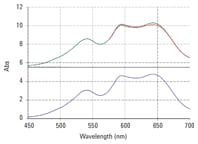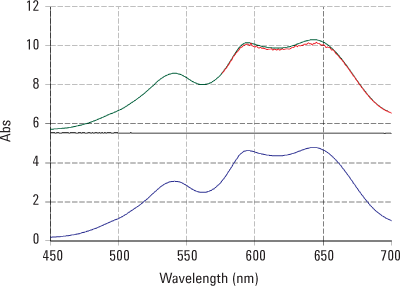Access Agilent eNewsletter, September 2013
>> Update My Profile | Subscribe to Access Agilent | Article Directory

Measure optical densities beyond 10 Abs with the Agilent Cary 7000 Universal Measurement Spectrophotometer
By Robert Frances
Agilent Senior Optical Engineer
and Travis Burt
Agilent Product Marketing Manager Cary UV-Vis-NIR
The measurement of high optical density (absorbance) is of significant importance to scientists, engineers, and manufacturers in applications that range from the rapidly expanding area of biophotonics to the manufacture of designer sunglasses. The Agilent Cary 7000 Universal Measurement Spectrophotometer (UMS) uniquely delivers the photometric accuracy, linearity, and dynamic range to accurately measure samples with high optical density.
To evaluate performance of this instrument in both the visible and NIR spectral ranges, we recently measured optical densities of materials used in the manufacture of highly attenuating optical filters. Using the addition of filters technique, we demonstrated photometric range, accuracy, and linearity that exceeded 10 absorbance units (Abs) at approximately 640 nm in the visible region and 8 Abs at about 1500 nm in the near infrared (NIR) region. This article describes the details.
Low-cost way to measure photometric linearity and range
The addition of filters technique provides a straightforward and inexpensive way to determine the photometric linearity and range of a spectrophotometer, without the need for expensive, calibrated standards. This method, applied to the visible portion of the electromagnetic spectrum, has been described in Agilent publication 5990-7843EN. In our study, we applied the principle in the visible and NIR spectral regions to confirm photometric performance prior to sample analysis.
We used rear beam attenuation when appropriate. When the incident light in the sample beam is highly attenuated, you need rear beam attenuation (RBA) to increase the dynamic range of the instrument. RBA balances the sample and reference signals (or light intensities) on the detector and is useful when you measure samples with high absorbance. You may achieve RBA by use of mesh filters of the type described below, or by use of the fully automated Agilent Cary Rear Beam Attenuator.
Measurements demonstrate addition of filters technique
For investigation of photometric range in the visible region, we measured the addition of a BG25 filter and attenuating mesh filters.
The data collection procedure was as follows: we installed 4.5 Abs attenuation in the rear beam, and then measured a baseline with a short spectral averaging time of one second. The BG25 and attenuating mesh filters were then measured separately. Next we lengthened the spectral averaging time to 50 seconds to perform a blocked beam measurement, followed by measurement of the BG25 filter and attenuating mesh filters together. All measurements were made in percent transmission (%T). We were particularly careful about filter positioning and movement between measurements.
 Enlarge
Enlarge
Figure 1. Spectra of BG25 filter (blue), attenuating mesh filter (black), and BG25 filter and attenuating mesh filter together (red). Green spectrum is the predicted result based on addition of blue and black spectra.
 Enlarge
Enlarge
Figure 2. Spectra of UG11 filter 1 (blue), UG11 filter 2 (black), and UG11 filter 1 and UG 11 filter 2 together (red). Green spectrum is the predicted result based on addition of blue and black spectra.
To process the data, we subtracted the blocked beam measurement from all filter measurements and converted the results to absorbance units. We added the individual spectra of the BG25 filter and the attenuating mesh filters to calculate the predicted spectrum for the measurement of all the filters together.
We used a similar protocol with measurements in the NIR region for the addition of two UG 11 filters.
Exceptional correlation between actual and predicted results
Figure 1 displays the results of the addition of filters measurements in the visible region. The actual (red spectrum) and predicted (green spectrum) show excellent correlation, with the maximum absorbance at approximately 640 nm exceeding 10 Abs. The good signal-to-noise of the combined filter measurement indicates the superior performance of the Cary 7000 UMS and its ability to detect extremely low light levels near the absorbance maximum.
Figure 2 shows the results of the addition of filters measurements in the NIR region. The actual (red spectrum) and predicted (green spectrum) show exceptional correlation, with the maximum absorbance at approximately 1500 nm exceeding 8 Abs.
Proprietary technology provides superior performance
The Agilent Cary 7000 UMS and the Agilent Cary 5000 UV-Vis-NIR are the only instruments on the market that use PbSmart Technology in their PbS NIR detector. PbSmart is a proprietary technique that controls Agilent PbS detectors. When coupled with the superior stray light and optical design of the instrument, you achieve industry leading NIR performance.
While not exhaustive, the addition of filter experiments confirm the ability of the spectrophotometer to make photometrically accurate and precise absorbance measurements at optical densities greater than 10 Abs in the visible region and greater than 8 Abs in the NIR region.
The addition of filters technique successfully demonstrates the photometric range, accuracy, and linearity of the Agilent Cary 7000 Universal Measurement Spectrophotometer in the UV-Vis-NIR region. If you need a spectrophotometer that provides accurate measurements at high optical densities, read the full Technical Note 5991-2528EN about this study. Then explore more information about use of the Agilent Cary 7000 UMS for measurement of advanced materials.
>> Update My Profile | Subscribe to Access Agilent | Article Directory

